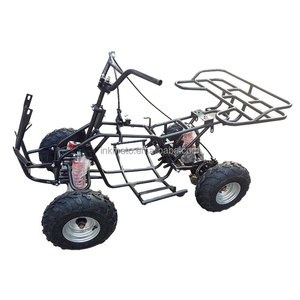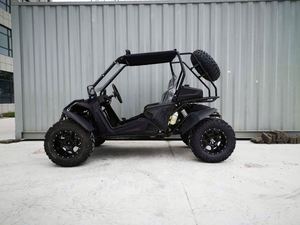(2737 products available)





































































































































































Buggy frame designs can be categorized into different types based on their usage and requirements. Each type is optimized for its specific purpose. Here are some types of buggy frame designs:
Buggy frames are useful in various industries and applications due to their adaptability and practicality. Here are some of the usage scenarios;
Recreation
Buggy frames are used for recreational activities like off-road exploring and amusement park rides. For instance, in the case of recreational carts and ATVs, where the focus is on enjoyment and adventure, frames constructed from robust materials like steel or tubing are necessary to support the vehicle's dynamic movements and off-road capabilities. Also, buggies for amusement parks require a strong frame to handle a large number of passengers and the stresses of various ride elements safely. Thus, frames for recreational buggies are essential for safety and durability, allowing fun and adventure.
Retail and Shopping
Buggy frames are used for shopping carts and strollers. Shopping cart frames are constructed from steel or aluminum tubing to make them strong enough to hold heavy items without breaking. Additionally, they must be able to move easily and be stackable for easy storage. On the other hand, stroller frames are made of light, durable materials that can support the weight of a child and the accessories that come with it while being portable and easy to maneuver. To sum up, frames for retail buggies are critical for their longevity and functionality, facilitating transportation within stores or on the streets.
Healthcare
Buggy frames are used for mobile patient carts and wheelchair buggies. For example, the frames for wheelchair buggies are made of sturdy materials that can support the weight of a person and the added stress of movement, making them essential for the user's comfort and safety. Also, they are made of light materials to ease movement and are strong enough to support the user, ensuring safety. Additionally, the frames for medical carts are made to be durable, with added compartments for medical supplies, and are designed to be easily movable within hospital premises, making them very helpful in the healthcare sector.
Transport
Buggy frames are utilized for luggage carts and golf carts. Golf carts are designed with strong and lightweight frames, ensuring they can accommodate passengers, clubs, and other cargo while remaining easy to maneuver and drive. Additionally, luggage carts feature frames made from durable materials to withstand the weight of multiple pieces of luggage, ensuring the safe and efficient transportation of passengers' belongings within hotels, airports, and other facilities. Moreover, the frames for freight buggies are crafted to be robust, with different compartments or spaces tailored to specific types of cargo, facilitating the organized and efficient transport of goods within warehouses, distribution centers, and other logistics hubs.
When selecting a buggy frame design, several factors must be considered to ensure the final product meets the user's needs and preferences. Here are some key points to consider:
Buggy frames come in several designs that serve different functions and feature requirements depending on the intended use, terrain, and user preferences. Here are some functions, features and design elements of buggy frames:
Material
Buggy frames are made from durable materials such as steel, aluminum, or magnesium. This ensures that they are strong enough to support the buggy's weight and the passenger's weight while being lightweight for easy maneuverability.
Adjustable and collapsible
Most buggy frames are designed to be collapsible or adjustable. This allows them to be easily folded or adjusted to different sizes for convenient storage and portability.
Rust and corrosion resistance
To improve the durability of buggy frames, they are usually coated with powder or painted. This makes the frame resistant to rust and corrosion, especially if the buggy is used in wet or harsh environments.
Reinforced joints
Frames have reinforced joints and welds to ensure structural integrity. This enables them to withstand repeated stress and heavy loads without breaking or deformation.
Shock absorption
Some buggies are fitted with shock absorption systems. This includes springs or shock absorbers that are synced with the frame. This minimizes the impact of bumps and rough terrain, providing a smoother ride.
Safety features
Buggy frames have safety features that include seat belts, safety harnesses, and roll cages. These features are essential for passenger safety, especially in high-speed or off-road buggies.
Ergonomic design
To enhance comfort, the buggy frames are designed to have an ergonomic seating position, handles, and controls. This design ensures that the user has a comfortable and safe experience even during long usage periods.
Compatibility
Buggy frames are designed to be compatible with various components, including wheels, steering systems, and drive systems. This allows for customization and the use of different parts without major modifications.
Weight distribution
Buggy frames are designed in a way that ensures proper weight distribution. This provides stability and prevents tipping over, especially in buggies designed for high speeds and off-road use.
Q1: What kind of material is used for making buggy frames?
A1: The materials used for making buggy frames are aluminum alloys, carbon steel, and magnesium alloys. Aluminum and magnesium alloys are lightweight and strong, while steel is used where more strength is required. The material used depends on the type of frame design and its end use.
Q2: Are buggy frames customizable?
A2: Yes, buggy frames are customizable. Users can choose different frame designs, materials, and colors according to their preferences. They can also select the required features and make the frame more functional. The customization option allows users to create a frame that meets their needs.
Q3: What are the common applications of buggy frames?
A3: Buggy frames are widely used in recreational sports and children’s entertainment. They are also used for product carts in large warehouses and for off-road vehicles in adventure rides.
Q4: What are the maintenance tips for buggy frames?
A4: The maintenance tips for buggy frames are regular inspection for signs of wear and tear, lubrication of moving parts, tightness of bolts and nuts, and cleaning with mild detergents.